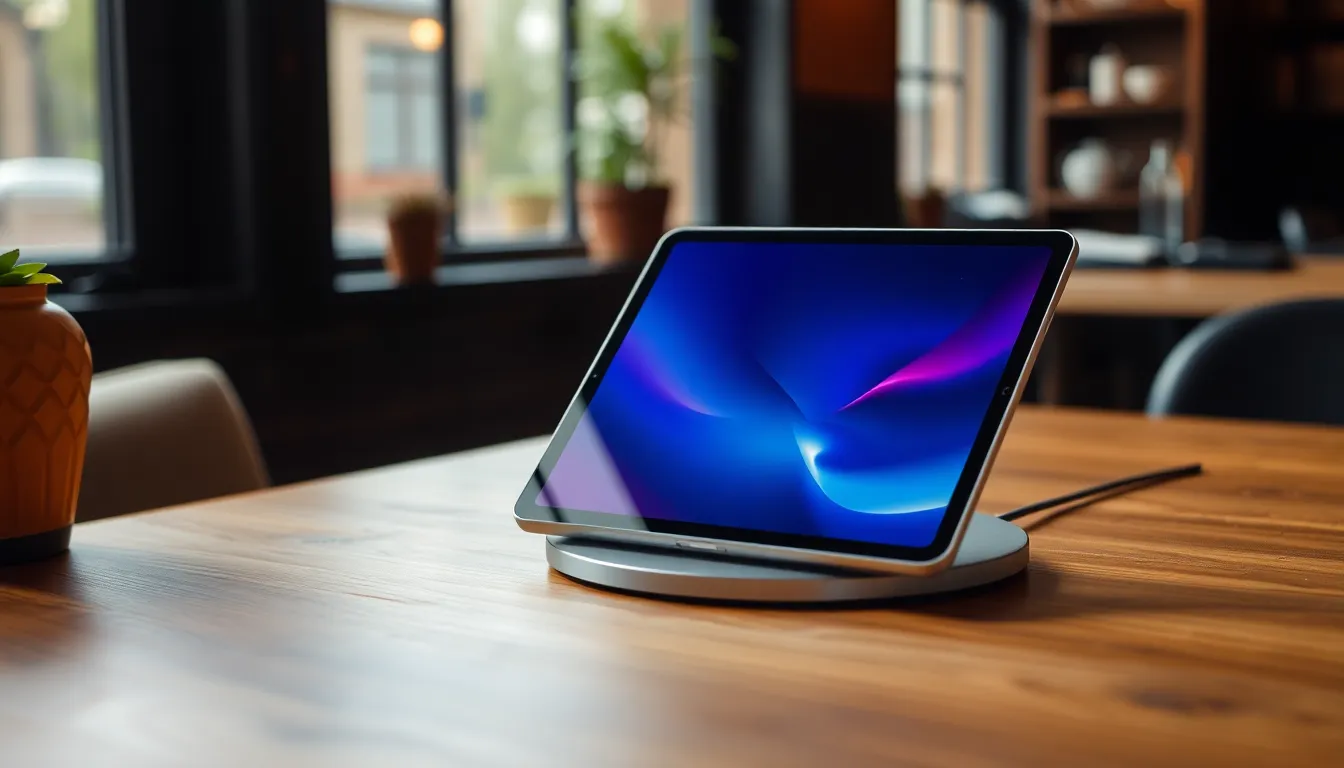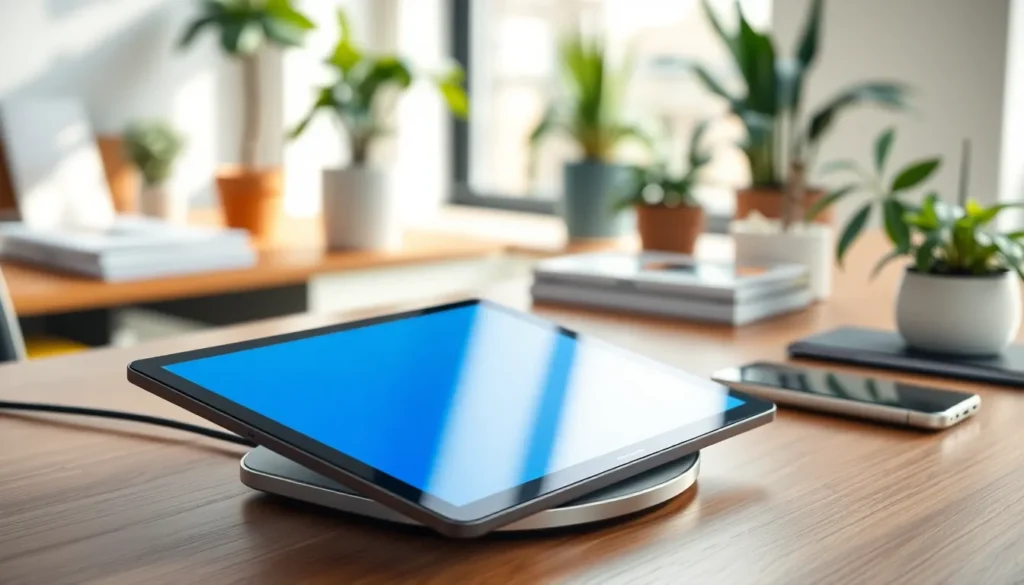Table of Contents
ToggleIn today’s fast-paced world, the last thing anyone needs is a tangled mess of charging cables. Enter tablets with wireless charging—where convenience meets cutting-edge technology. Imagine plopping your tablet down on a sleek charging pad, and voilà! It’s juiced up and ready to go, all without the hassle of plugging in.
Overview of Tablets with Wireless Charging
Tablets that incorporate wireless charging technology provide significant convenience. Users can recharge devices quickly by simply placing them on a compatible charging pad. This feature aligns seamlessly with modern lifestyles, where efficiency is crucial.
Certain brands lead the market by offering models with advanced wireless charging capabilities. Apple, Samsung, and Microsoft have introduced tablets that enhance user experience through this technology. These devices often feature sleek designs that complement their functionality.
Functionality extends beyond just charging. Many tablets with wireless capabilities offer rapid charging options, allowing users to power up their devices in shorter timeframes. As battery life becomes more critical, this feature caters to the demands of a busy schedule.
Compatibility is another important aspect. Tablets equipped with wireless charging generally support a range of charging pads and accessories. This flexibility ensures users can find suitable charging solutions without needing proprietary equipment.
In terms of practicality, manufacturers often integrate additional features into these tablets. Features may include improved battery management systems and energy-efficient designs. Such enhancements not only support wireless charging but also prolong device lifespan.
Price points for tablets with wireless charging can vary significantly. Some models target budget-conscious consumers, while high-end options cater to professionals and enthusiasts. Understanding the range of options available helps users make informed choices based on their needs and preferences.
Overall, tablets with wireless charging offer a blend of technology and user convenience. Their presence continues to grow in consumer markets, capturing interest from a diverse user base. The ongoing advancements in wireless charging technology promise even more innovative features in the future.
Benefits of Wireless Charging

Tablets equipped with wireless charging offer significant advantages that align with modern user needs in convenience and efficiency.
Convenience and Portability
Users enjoy the simplicity of placing a tablet on a charging pad to initiate charging. This approach eliminates tangled cables and the hassle of managing multiple chargers. Tablets with wireless charging are often more portable, making it easy to recharge them on the go. Various charging pads can fit seamlessly into different environments such as offices, cafes, and homes. Leading brands ensure these devices remain accessible, allowing users to power up without searching for a cable.
Reduced Wear and Tear
Wireless charging minimizes wear on ports, leading to improved longevity of devices. Constantly plugging and unplugging a tablet can cause damage to charging ports over time. Tablets that utilize wireless charging avoid this problem, reducing maintenance issues. Users benefit from the extended lifespan of their devices when utilizing this technology. As manufacturers introduce robust battery management systems, efficiency increases, further promoting overall device health. Selecting tablets with wireless charging leads to a smoother, worry-free experience.
Popular Tablets with Wireless Charging
Tablets featuring wireless charging are gaining popularity among users seeking convenience and efficiency. Below are notable examples of tablets with leading wireless charging technology.
Tablet 1: Features and Performance
Apple’s iPad Pro offers seamless wireless charging capabilities, allowing for quick and easy recharging. This tablet features a vibrant Liquid Retina display that enhances multimedia experiences. It also includes the M1 chip, which delivers powerful performance for demanding applications. Battery life reaches up to 10 hours, making it suitable for extended use throughout the day. Users benefit from compatibility with Apple’s Smart Connector accessories, further enhancing functionality. With an elegant design and robust build quality, the iPad Pro meets the needs of both casual users and professionals alike.
Tablet 2: Features and Performance
Samsung Galaxy Tab S7+ stands out with its sleek design and efficient wireless charging support. This tablet is equipped with a Super AMOLED display, providing stunning visuals and vibrant colors. Performance remains top-notch thanks to the Qualcomm Snapdragon processor, ensuring smooth multitasking. Battery longevity reaches approximately 14 hours, ideal for long commutes or travel. Additionally, it includes support for the S Pen, enhancing productivity and creativity. With its balance of performance and versatility, the Galaxy Tab S7+ appeals to various user preferences.
Comparison of Wireless Charging Standards
Wireless charging technology encompasses various standards that enable seamless energy transfer. The most prominent among these standards includes Qi, which enjoys widespread adoption across many devices.
Qi vs. Other Standards
Qi stands out as the leading wireless charging standard, utilized by numerous tablet manufacturers. Competing standards, such as PMA and A4WP, lack the same level of popularity. Many accessories work with Qi-certified devices, promoting interoperability. Tablets from brands like Apple and Samsung integrate Qi, ensuring compatibility with various charging pads. Legacy technologies, including PMA, tend to focus on specific networks and often see limited support from contemporary devices. Overall, Qi simplifies the charging process, allowing users to recharge multiple tablets and smartphones without requiring specialized equipment.
Charging Speed Differences
Charging speed varies significantly between wireless standards. Qi typically offers power levels ranging from 5W to 15W for most devices. Higher-end options, such as Qi Fast Charge, can deliver faster power transfer when both the charger and device support it. Other standards may lag behind, with some providing only lower wattages. Samsung’s Galaxy Tab S7+ utilizes a 15W charging capability, enhancing its user experience. Meanwhile, tablets charged with PMA frequently see slower rates, limiting their convenience for busy users. Variability in charging speeds impacts device usability; thus, selecting a tablet that aligns with charging needs ensures optimal performance.
Future Trends in Wireless Charging for Tablets
Advancements in wireless charging technology will significantly impact tablet design and functionality. Manufacturers focus on enhancing efficiency, leading to faster charging speeds and improved energy management systems. User convenience continues to drive innovation, with features like multi-device charging and longer ranges becoming standard expectations.
Collaboration among tech companies fosters compatibility across different devices. Users can soon expect tablets that charge seamlessly on various charging pads without needing proprietary accessories. Increased battery life and optimized charging cycles mean that devices will be ready for use more quickly and remain operational longer.
Sustainability emerges as a critical trend, with many brands developing eco-friendly materials and energy-efficient designs. Tablets featuring recyclable components resonate with environmentally conscious consumers who prioritize sustainability in their purchasing decisions. Creating devices that minimize environmental impact can enhance brand loyalty.
Integration of artificial intelligence within charging technology promises smarter charging solutions. Intelligent systems could analyze user behavior to optimize charging times, ensuring that tablets charge when necessary. Users can benefit from tailored charging experiences that consider individual usage patterns.
Finally, the rollout of next-generation wireless standards like Qi 2.0 may redefine charging capabilities. Improved efficiency and increased power output could revolutionize how users interact with their tablets. Such advancements will solidify wireless charging as essential in tablet functionality, aligning with the growing demand for convenience and portability.
Tablets with wireless charging represent a significant leap in convenience and functionality. As technology evolves manufacturers are committed to enhancing user experiences through innovative designs and efficient charging solutions. The seamless integration of wireless charging not only simplifies daily routines but also supports a more sustainable approach to device management.
With leading brands continually pushing the boundaries of what’s possible it’s clear that the future of tablets will be shaped by advancements in wireless technology. Users can look forward to faster charging speeds improved energy management and increased compatibility across devices. As these trends unfold wireless charging will undoubtedly become an indispensable feature for tablet users everywhere.




